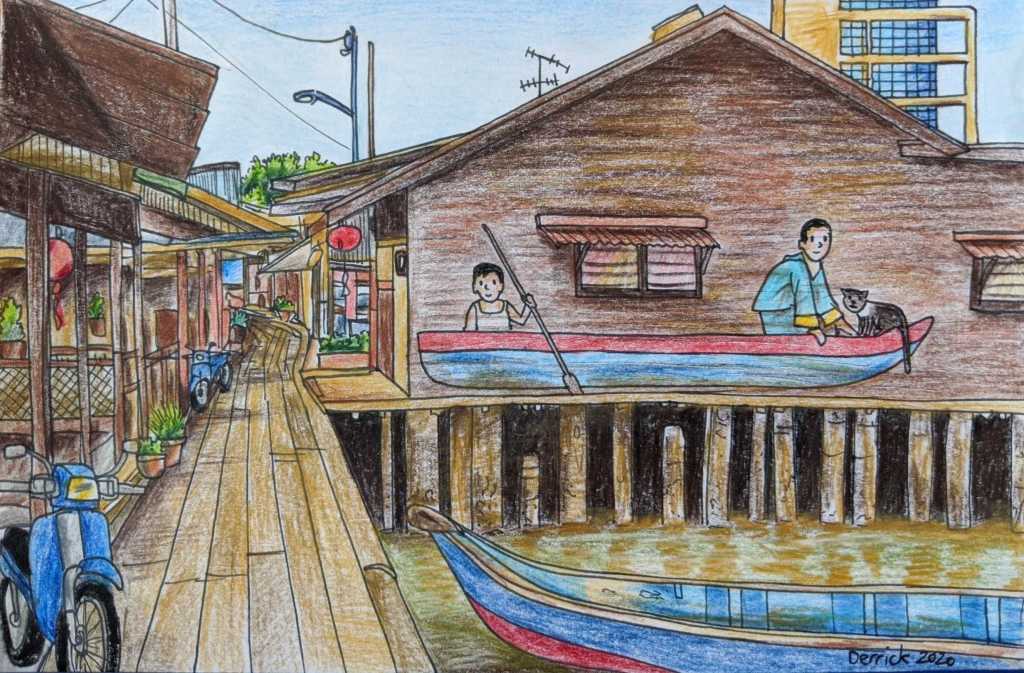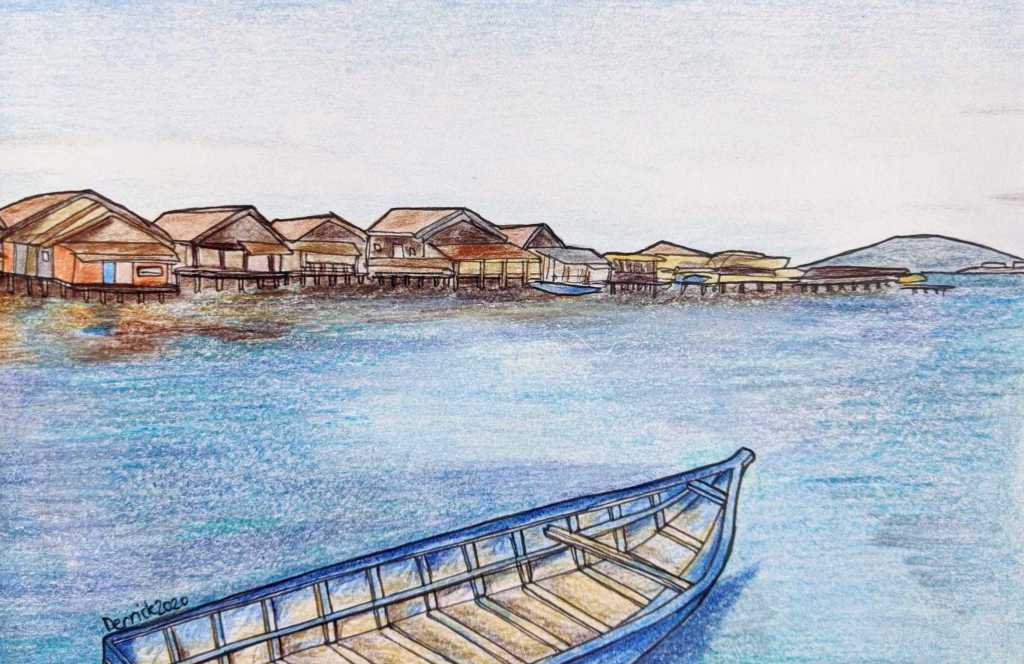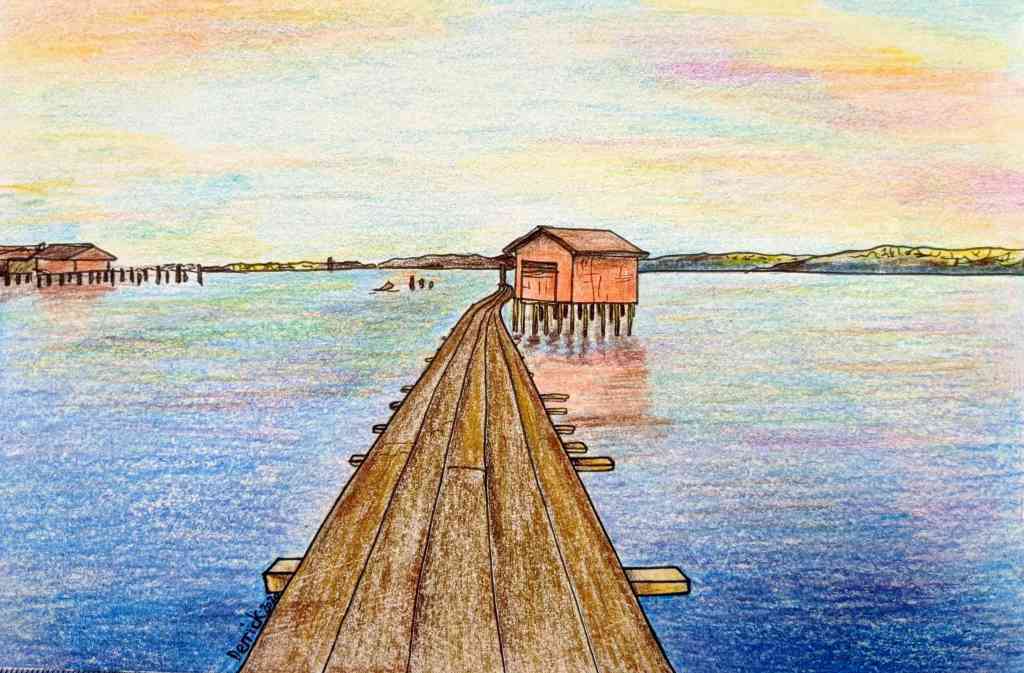The Clan Jetties of Penang are historic Chinese villages built out over the water on long jetties. Typically, each Jetty belongs to a single family clan, with dozens of wooden houses on each Jetty. Located in George Town, Malaysia, the Clan Jetties are a reminder of Penang’s multicultural history. There have been 10 jetties in total, however devastating fires and recent construction projects means 4 have been since destroyed. The most well-known Jetty is the Chew Jetty, which is open so visitors can observe what life on a Clan Jetty is like.

Origin Of The Clan Jetties
The Clan Jetties were established in the 19th century as Chinese immigrants arrived on Penang, seeking housing in a fast-growing port city. The city was experiencing an economic boom due to its strategic position as a British shipping centre to export tin, as well as a major spice production centre.
Merchants were attracted to Penang, as were traders, accountants and labourers. The city became a multicultural hub for Malay, Chinese, Indian, Eurasian and other cultures. Many Chinese arrivals worked as dock workers and boat operators on local sampans, ferrying people and cargo. To stay close to their work by the waterfront, and to help their chances of setting up local Chinese communities, the ramshackle Clan Jetties were established over the water.
UNESCO Listed George Town
George Town is one of the biggest and most vibrant cities in Malaysia, located on the island of Penang. It’s known for being Malaysia’s gastronomic capital (especially it’s hawker street food!), its eclectic mix of architectural styles, and its multicultural community. In 2006, the historic cities of George Town and Melaka were awarded UNESCO World heritage status. The city is easily reached by road, with two bridges connecting the island to the mainland.
Life On George Town’s Clan Jetties
The Clan Jetties still retain traditional Chinese culture and customs today. Each Jetty has its own small temple at the entrance and at the very end of the Jetty, facing outwards towards the sea to grant the residents good fortune.
The Jetties require constant maintenance, with the wooden stilts needing replacement every 5 years. Because of the challenges of maintaining the structures, many younger people choose now to live in apartments or houses in the city. The Jetties have all the modern conveniences of any other house, with electricity, telephone wires, running water, and air conditioning. Some of these amenities were added just a few decades ago, greatly improving what were previously quite poor living conditions. As for sewerage – the sea takes care of that! Unfortunately, garbage being thrown into the surrounding waters by both residents and visitors is still an ongoing problem.
Life on the Clan Jetties does have its conveniences, with some Jetties featuring hairdressers and internet cafes situated amongst the houses. Many residents have set up little gardens of pot plants, and they ride their motorcycles up and down the boardwalk to their parking spots.

The Different Clan Jetties
6 Clan Jetties survive today, from a total of 10 that were built over the last century and a half. Each one is named after the family clan name, and each has its own style and personality.
Chew Jetty
Chew Jetty is the only Penang Jetty open to the public, and is also the oldest and the largest of the Clan Jetties. Chew Jetty was built in the mid-nineteenth century, and as the clan grew, more houses were added, pushing the Jetty further out to sea. Today, there are 75 houses, and around 600 residents.
Chew Jetty is the only Jetty open to the public to freely explore, and in addition to an explosion of tourist-oriented shops selling souvenirs and food, the Jetty even has accommodation for tourists to stay in. Its status under the umbrella of a UNESCO World heritage site gives it extra tourist attention which the Jetty may not appreciate. Busloads of tourists are dropped off at its entrance, and as a result, many windows are boarded up, with No Photo signs commonplace.
There are festivals and celebrations along Chew Jetty too, such as the ninth day of Chinese New Year, when Chew Jetty hosts a large public procession to honour the Jade Emperor. Chew Jetty also features wonderful mural artwork from Ernest Zacharevic, a street artist who has worked extensively in Penang.
The Chew Jetty was partially destroyed in 2009 when a fire broke out, destroying 5 houses. Believed to be caused by an electrical short circuit, some residents leapt into boats to escape the flames. Luckily, nobody was injured.
Tan Jetty
Built in the late nineteenth century, Tan Jetty was originally home to a clan of fishermen. Tan Jetty is best known for the Mazu temple, the small red temple standing alone at the end of the pier which honours the goddess of seafarers.

Lee Jetty
The Lee Jetty was built by the Lee families, coolies (labourers) from the Fujian province of China. The Lee Jetty is one of the most photogenic Jetties at night, as it is illuminated with hundreds of colourful lights and lanterns.
Mixed Clan Jetty (New Jetty)
The Mixed Clan Jetty is the only Jetty which didn’t start off with just one clan. The Jetty was made up of labourers of different families who worked on the shore. It is also the most recently built Jetty, established in the 1960’s, earning the nickname the New Jetty. It is one of the smallest Jetties, with 22 houses.
Yeoh Jetty
The southernmost Jetty is the Yeoh Jetty, built in the late nineteenth century. The Yeoh Jetty is positioned looking out over the Penang Strait, with mainland Malaysia visible in the distance. Where once the Jetty was built over the water, lower tides means that the Jetty now stands mostly on mud flats. It retains much of its original charm, with few modern rebuilds.
Lim Jetty
The Lim Jetty, one of the longest Jetties, was built in the late nineteenth century. It was damaged during the Japanese occupation in WW2, and was rebuilt when the war ended.
Destroyed Clan Jetties
Before the Clan Jetties were protected by the city’s UNESCO World heritage status, they were in danger of obstructing building projects due to their position on valuable port real estate. The other major threat to the Clan Jetties is accidental fire.
Koay Jetty
The Koay Jetty, built in the 1950s, was different from the others. While ethnically Chinese, the Koay families were Muslim, with roots tracing back to Arab traders. The Jetty also differed in its design; the houses were arranged on only one side of the Jetty, extending out onto a landscape of mud flats, pockmarked with the tiny holes of skittish mudcrabs. Unfortunately, the Koay Jetty was demolished in 2006 to clear space for large apartment complex developments.
Peng Aung Jetty
Similar to the Koay Jetty, the Peng Aung Jetty was razed in 2006 to make way for the block of flats near the Jelutong Expressway.
Gat Lebuh Noordin Jetty and Gat Lebuh Sandilands Jetty
Two other jetties once stood beside the others, but were destroyed by fire, one of the greatest threats to the mostly wooden structures. Fire tore through the Gat Lebuh Sandilands Jetty in 2000, claiming 60 houses, and the Gat Lebuh Noordin Jetty was also destroyed in 2003, destroying 50 houses.
***
Visiting the Clan Jetties is easy. They are located next to each other along Weld Quay, just a short drive by auto rickshaw from George Town old town. There is even a great food court just opposite Chew Jetty to eat some delicious hawker food afterwards. But it’s important to be respectful with visitation and photographs, as the jetties struggle under the weight of newfound mass tourism. The Clan Jetties are unique sight, and are worth a visit for those interested in Penang’s culture and history.
If you’re interested in life on the water, check out my post on the world of Dutch houseboats!
One thought on “The Clan Jetties Of Penang – George Town’s Historic Floating Villages”
Comments are closed.